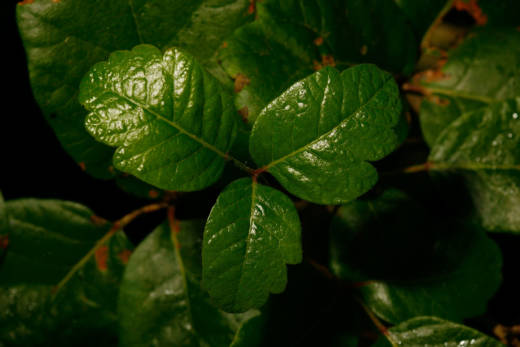While the exact cause of the neighborhood’s bout with skin rashes remains unknown, many residents began linking it to nearby wildfires at the time, including the Oregon St. Fire that burned more than 200 acres.
When Pacific poison oak burns, the urushiol oil in the plant dissipates in the air and is then distributed by the wildfire smoke, according to the U.S. Forest Service.
Poison oak is highly immunogenic, meaning even mild exposure can trigger an eruption, according to Dr. Emmanuel Maverakis, an associate professor of dermatology at U.C. Davis.
“Poison oak is one of the strongest allergens out there,” says Maverakis. “People have varying sensitivity but the vast majority will likely experience a reaction. Even a single exposure can cause an allergic response.”
Maverakis, however, urged caution and said widespread poison oak poisoning from wildfires is rare.
In terms of how close you actually have to be to contract poison oak via wildfire smoke, no clear guidance has yet been issued, however, experts say that individual variables like wind and personal sensitivity play a factor.
“The farther away you are from the fire,” says Maverakis, “the less exposure you will have.”
About 70 to 85 percent of the population will develop an allergic reaction to poison oak although it seldom occurs on the first exposure, according to the U.S. Forest Service.
“Sensitivity increases with each exposure,” says the U.S. Forest Service. “People who are exposed to urushiol oil repeatedly may become more sensitive, reacting to lower and lower concentrations. However, people become less sensitive to urushiol oil as they get older.”
In the case of Rancho Cordova, Dr. Maverakis says that, based on the few photos he’s seen of residents’ rashes, the sun is a more likely culprit.
“This is, after all, sunburn season and the thing with a sunburn is that it doesn’t happen right away,” he says. “It would be easy for someone to blame a rash on other causes if it developed hours later.”
Symptoms of poison oak usually develop within 24 hours of exposure and include rash, itching and swelling, according to the Centers for Disease Control and Prevention.
In 2017, more than 400 firefighters battling wildifres in Santa Barbara County alone were treated for poison oak, according to Firehouse News.
“Poison oak is just a hazard of the job,” Santa Barbara County firefighter Danny Haynes told KEYT during the 2017 wildfires. “There’s poison oak on almost every fire we go on here on the Central Coast.”
If you believe you have been exposed to urushiol oil from poison oak, the CDC recommends the following steps:
- Immediately rinse skin with rubbing alcohol, specialized poison plant washes, dishwashing soap, and plenty of water.
- Rinse frequently. Make sure that wash solutions do not dry on the skin and further spread the urushiol.
- Scrub under nails with a brush.
- Apply wet compresses, calamine lotion, or hydrocortisone cream to the affected area to reduce itching. Do not apply to broken skin.
- Take an antihistamine such as Benadryl for itching.
- In severe cases, such as difficulty breathing or if the rash is on the face or genitals, seek immediate medical attention.

